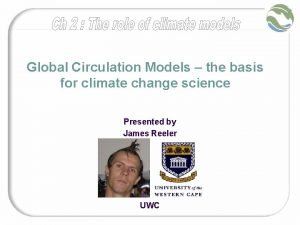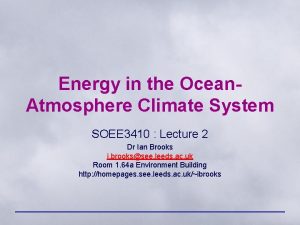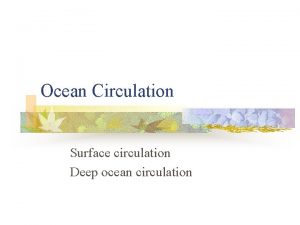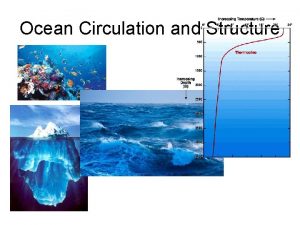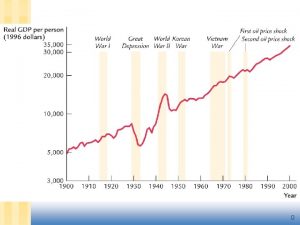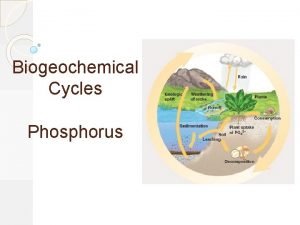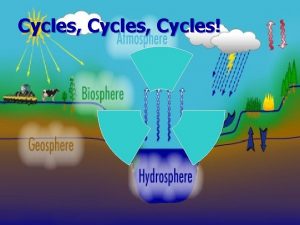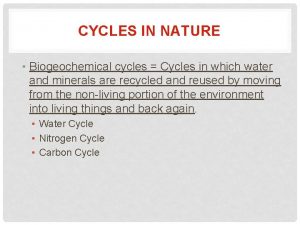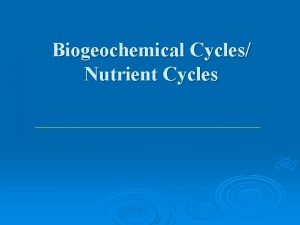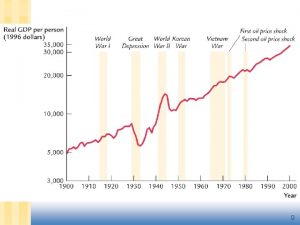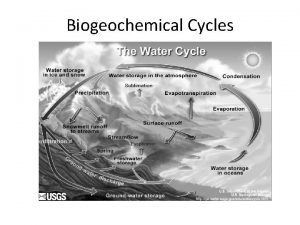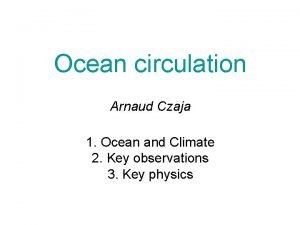Ocean circulation and climate cycles Ocean circulation and














- Slides: 14

Ocean circulation and climate cycles

Ocean circulation and climate cycles • Ocean circulation patterns are important contributing factors in many well-known and predictable climate variations. Weather patterns in a given region of the Earth can be affected at any given time by one or more of these climate cycles, depending on the areas that they cover and whether they overlap in time. Measuring the variables that signal switches in climate cycles, such as changes in ocean temperature and atmospheric pressure, is an important research focus for ocean and atmospheric scientists who are working to make better predictions of climate and weather cycles. • Global Warming's Impact on Ocean Currents to Amplify Sea Level Rise

• Monsoons are a well-known example of a seasonal climate cycle. These storms arise when land water heat up at sharply different rates. As land temperatures increase during summer months, hot air masses rise over the land create low-pressure zones. At the surface, ocean winds blow toward land carrying moist ocean air. When these winds flow over land are lifted up by mountains, their moisture condenses and produces torrential rainfalls.

• In winter this pattern reverses: land cools more quickly than water, so air rises over the warm oceans and draws winds from the continents, producing high pressure and clear weather over land. In Asia, winter monsoons occur from December through March and summer monsoons take place from June through September. Summer monsoons also occur from July through September in Mexico and the southwestern United States.

Monsoon rains are crucial to agricultural production in India.

• Hurricanes develop on an annual cycle generated by atmospheric and ocean conditions that occur from June through November in the Atlantic and from May through November in the eastern Pacific. The main requirements for hurricanes to develop are warm ocean waters (at least 26. 5°C/80°F), plenty of atmospheric moisture, and weak easterly trade winds, A typical North Atlantic hurricane season produces eleven named storms, of which six become hurricanes, including two major hurricanes (Category 3 strength or higher).

ENSO • The best-known multi-annual climate cycle is the El Niño Southern Oscillation (ENSO), which is caused every three to seven years by changes in atmospheric and ocean conditions over the Pacific Ocean. Normally a large gyre sits over the southern Pacific. When this gyre is strong, winds along the coast of South America and trade winds that blow west along the Equator are strong. These winds pile warm surface waters up in the western Pacific and produce coastal upwelling of cold, nutrient-rich water that supports major fisheries near the coast of South America. This pattern is called the Walker Circulation, named for its discoverer, British scientist Sir Gilbert Walker. • El Nino - What is it?

What happens in an El Nino year? • In an El Niño year, the gyre weakens and this pattern flips into reverse. Atmospheric pressure rises over Asia and falls over South America, equatorial trade winds weaken, and warm water moves eastward toward South and Central America and California. Coastal upwelling in the eastern Pacific dwindles or stops. Warm, moist air rises over the west coasts of North and South America, causing heavy rains and landslides as droughts occur in Indonesia and other Asian countries. The event was originally named El Niño (meaning "the Christ Child") by South American fishermen because coastal waters often began warming around Christmas. Major El Niño events occurred in 1982– 1983 and 1997– 1998: each cycle killed several thousand people (mostly through flooding), triggered major forest fires in Asia, and caused millions of dollars' worth of property damage. • Describe, in steps, what causes an El Nino event.

Normal and El Nino Conditions El Niño and La Niña affect weather and climate around the globe.

La Nina • During a La Niña event (an unusually intensive reverse phase of El Niño), Pacific water temperatures become unusually cold and coldwater upwelling increases along western South America. La Niña episodes produce unusually wet weather in Asia and drier than normal conditions in much of the United States. A full El Niño/La Niña cycle lasts for about four years. • El Niño and La Niña Explained

Pacific Decadal Oscillation • Other ocean/atmosphere climate cycles happen on even longer time frames. The Pacific Decadal Oscillation (PDO) is a 20 - to 30 -year cycle in the North Pacific Ocean. Positive PDO indices (warm phases) are characterized by warm Sea Surface Temperature (SST) anomalies along the Pacific coast and cool SST anomalies in the central North Pacific. Negative PDO indices (cold phases) correspond to the opposite anomalies along the coast and offshore. They intensify the Aleutian Low pressure cell, a semi-permanent atmospheric pressure cell that settles over the North Pacific from late fall to spring. • What is the PDO? • What is Pacific Decadal Oscillation (PDO)?

• Cool PDO phases are well correlated with cooler and wetter than average weather in the western United States. During the warm phase of the PDO, the western Pacific cools and the eastern Pacific warms, producing weather that is slightly warmer and drier than normal in the western states. Since the North American climate anomalies associated with PDO extremes are similar to those associated with the ENSO cycle, the PDO can be seen as a long-lived El Niño-like pattern in Pacific climate variability.

The North Atlantic Oscillation • The North Atlantic Oscillation (NAO), another multi-decadal cycle, refers to a north-south oscillation in the intensities of a low-pressure region south of Iceland a high-pressure region near the Azores. Positive NAO indices mark periods when the differences in Sea Level Pressures (SLP) are greatest between these two regions. Under these conditions, the westerly winds that pass from North America between the high and low pressure regions and on to Europe are unusually strong, and the strength of Northeast Trade Winds is also enhanced. This strong pressure differential produces warm, mild winters in the eastern United States and warm, wet winters in Europe as storms crossing the Atlantic are steered on a northerly path. • What is the NAO?

• In the negative phase, pressure weakens in the subtropics, so winter storms cross the Atlantic on a more direct route from west to east. Both the eastern United States and Europe experience colder winters, but temperatures are milder in Greenland because less cold air reaches its latitude.
 Single circulation and double circulation
Single circulation and double circulation Single circulation and double circulation
Single circulation and double circulation Structure of bronchioles
Structure of bronchioles Slowing atlantic ocean circulation
Slowing atlantic ocean circulation Climate change 2014 mitigation of climate change
Climate change 2014 mitigation of climate change Ocean atmosphere and climate
Ocean atmosphere and climate Ocean atmosphere and climate
Ocean atmosphere and climate Why are tropical climates so hot brainpop
Why are tropical climates so hot brainpop Chapter 15 ocean water and ocean life
Chapter 15 ocean water and ocean life Compare and contrast carbon and nitrogen cycles
Compare and contrast carbon and nitrogen cycles Site:slidetodoc.com
Site:slidetodoc.com Ocean ocean convergent boundary
Ocean ocean convergent boundary Ocean to ocean convergent boundary
Ocean to ocean convergent boundary Ocean ocean convergent boundary
Ocean ocean convergent boundary Crack watc
Crack watc



